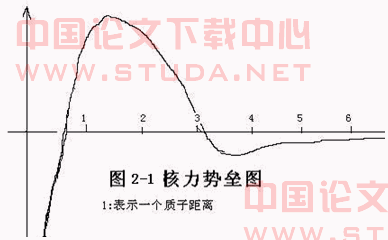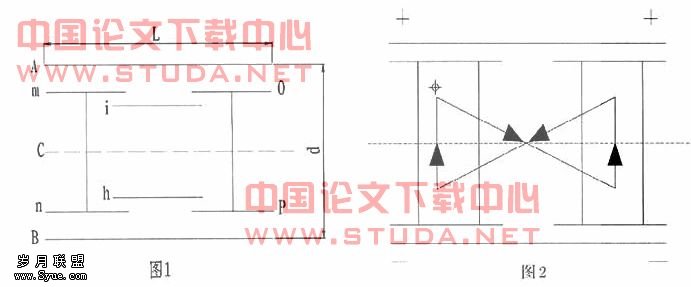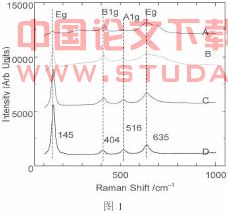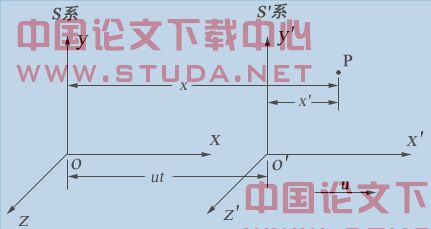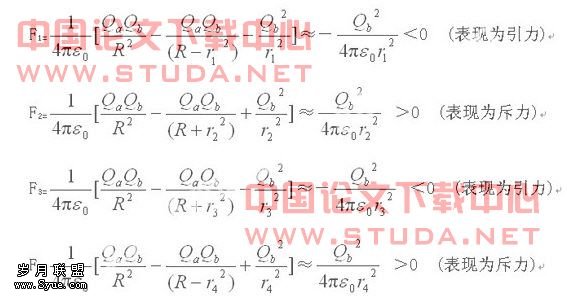时间理论(Theory of Time)
目录:
Table of contents
前言
Introduction
1客观时间
The objective time
绝对客观时间
The absolutely objective time
相对客观时间
The relatively objective time
2 主观时间
The subjective time
绝对主观时间
The absolutely subjective time
相对主观时间
The relatively subjective time
模糊主观时间
The indefinitely subjective time
3 什么是时间单位?
What is the unit of time?
4 时间是直线的,还是弯曲的?
Is time curved or straight?
5 时间的定义是什么? 时间的本质是什么?
What is the definition of time? What is the essence of time?
6 时间的表达式
The formulation of time
7 时间系统图
The chart of “Time System”
结束语
End remarks
前言:
Introduction
物质,空间,能量,时间是物的基本组成部分,但是它们的定义和本质还在困惑着我们。和上对时间的进一步认识会为我们对客观世界和规则有更深层次的理解,“时间理论”的提出就是基于这样的一种努力。
Matter, space, energy and time, they are the fundamental parts in physics today, though their definitions and the essence are still perplexed for answers. Further interpretations of time in science and philosophy will make us more understanding of the world and the natural laws, and advancing the “theory of time” typically based on such an effort.
寻求宇宙真理是哲学和科学的目的,哲学家没有必要去知道宇宙的数学表达式应当是怎样的,只要了解其出的结果就行了;科学家也不要太去担心自己被划分成什么主义,而只要懂得哲学里有很多有用的思想和方法就可以了。
Seeking for the Truth of the Cosmos is the goal of philosophy and science. Philosophers need not know what the mathematical equation of the universe should be, but know the result computed by the expression; and it is not necessary for scientists to worry too much about “what-ism” they were sorted out, but necessarily realize that there are many useful thoughts and methods in philosophy.
时间是我们生活中最重要的组成成分之一。对时间的讨论经历了几千年,留给我们的概念仍然是模糊和局部的。尽管到现在人们对时间的定义和时间的本质还没有统一认识,就像其他很多概念没有被解去面纱一样,它并没有影响人类的基本生活和科技的快速。
Time plays an extremely important role in science and our lives. Controversies have been lasting for thousands of years, but the concept of time left us is still indefinite and partial. Though there were widely divergent views about its definition and its essence, time made no difference to our development in science and technology.
“时间理论”采用的讨论方法,既不是针对某些我认为是错的或者不同的观点,也不是针对某些我认为值得尊敬的人而进行论述的,它是建立在系统研究基础上,对时间概念进行全方位的诠释。
The discussions in the “theory of time” neither focused on the certain views assumed they might be wrong or different, nor aimed at those venerable people. The theory of time was founded on the basis of systematic research.
现代科学和哲学的发展为我们揭开时间之迷提供了基础,我的尝试是把时间做了统一分类,并对什么是时间和时间本质作了解释,另外,我还尽可能多地指出一些人们对时间概念错误的认识。对时间进行分类就像对生物进行分类一样,这将会使人们对时间的理解和进一步研究变得容易起来。
The achievements of modern science and philosophy provided the possibility to unveil the secret of time. Consequently my attempt was to classify the time, to tell what is “time” and what its essence should be, and, moreover, I was trying to point out some misconceptions of time. The classification of time, such as the species in biology, would be an important approach that made our researches on time become easily.
时间理论里附了许多的图片说明,这些都会为你逐渐理解时间概念提供帮助;文中的有些例子,为了加强你的理解和记忆,我特意做了重复举例使用,当然,你也可以为巩固你的知识,提出自己的例子进行对照,以便能加深对时间的理解。
这篇文章是为所有对时间概念感兴趣的人设计的,希望能使你对时间有一个全面的,新角度的认识。
“Theory of time” provides this approach making you gradually learn the concept of time with many paradigms and diagrams. Some instances were repeated in order to enhance our understandings and memories, as well as to reduce our unnecessary speculation. However, you might deepen your comprehension with you own examples. It is hoped that you will view the time at a different angle. Meanwhile, the article is designed for all viewers who are interested in the field.
1. 客观时间(The objective time)
首先,为了不在开始的时候去面对太多的抽象概念,我分步骤地为你介绍“时间的种类,”我想这样能使你比较容易地理解时间的全貌。对时间的理解,我知道每一步都是“艰难”的,希望现在开始后不会是这样。我们都知道,时间可能会改变一切,你可以花些时间仔细阅读,也可以任意挑选你感兴趣的章节。好了,现在就让我们开始我们的“时间旅行”。
First of all, in order to avoid thinking too many abstract notions at the beginning, I would like to introduce you the “variety” of time step by step, which I thought somehow they are the “easily understandable” aspects of time. I knew every step was hard, and hopefully not so from now on. Take your time and read the article freely. Time might change everything. Now let’s start our “time travel”.
时间分为“客观时间”和“主观时间”。
Time is divided into “objective time” and “subjective time.”
所谓“客观时间”就是那些:不以意识或观测者存在与否而存在的。
The Objective time: exists no matter whether there are observers or human beings.
相对论突出的贡献之一是提供给我们的“时空(space-time)”概念。有些相对论者认为时间不能独立于空间单独存在――空间是时间的主体,这个论述恐怕没有多少人愿意或有勇气去反驳,尽管有不少怀疑者。这里我做个小把戏,现在我们把一“空间”弄得与宇宙一样大,根据他们的理论,那么我们就找到了“宇宙时间”(the Universal Time)。其实,宇宙时间是亘古存在的,它伴随宇宙的存在而存在,而与小把戏(空间)没有任何联系(更多在第五部分)。
One of the notable contributions of Relativity is the notion of “space-time.” The relativists do not treat space and time independently—space is the subject of time, which nobody is willing to rebut at the moment. Thus I play a “trick”: Let us blow “space” as big as the Universe’ room, according to their theory, then we would find out the Universal Time. Actually the universal time has existed for a long, long time, and it will accompany the universal life throughout the whole evolution, and it does not matter with the “trick (space) ”(more in part 5).
众所周知,宇宙有过去和现在,正是由于有这样的变化,才表明了宇宙时间的存在。如果在科学技术允许的情况下,我们可以通过“时钟”测量到“宇宙时间。”
“宇宙时间”是一个客观时间,它的存在和是否命名它,取什么样的名字无关,我把这个时间分类到“绝对客观时间。”对客观时间的研究是科学领域的范畴。所说的客观时间就是一种客观存在,正如我们看不到电磁场,但我们可以通过仪器测量到它;时间,同样,我们也可以通过仪器测量到它的变化,所以,时间并不是概念上或想象的‘东西’。客观时间包括绝对客观时间和相对客观时间。
As known, the Universe has past and present, and just because of this kind of change, it indicates the existence of the universal time. With the permission of science and technology, we could measure the universal time by “clock.” The universal time is an objective time, which exists no matter whether we named it or not, and I sorted it out into the part of “absolutely objective time.” The study of the objective times belongs to the scientific realm. So-called “the objective time” means time is a kind of existences, such as we can not see the Earth’s magnetic field which it can be measured by instruments; time, also, we can capture by the chronometers, i.e. time is not conceptive or imaginary “thing.” The objective time includes absolutely objective time and relatively objective time.
绝对客观时间: 指宇宙时间和宇宙中个体的寿命。
The absolutely objective time: includes the universal time and the bodies’ life-span.
宇宙时间是一个进行着的时间,而宇宙个体的寿命是一个绝对的量,即一个绝对的时间期间,举个例子,想一下一个恒星的寿命或者一个分子的寿命。由于我们还无法准确地确定宇宙时间是何时开始的,我们还无法利用这个时间来作为参照坐标(标准时间)。但是,我们可以通过科学计算或观测了解绝对客观时间,例如,科学家通过观测和计算可以推测恒星是什么时间开始和结束的。想了解我们每个人的生命时间是何时开始,我们最好去查找出生记录;如果把我们生命开始的时间定于受精那一刻,我们就不得不暴露父母的隐私。如果以宇宙时间为参照坐标(标准时间),宇宙中任何一点发生的时间都是同时的。
The universal time is a progressive time, and a body’s life-span is an absolute quantity--an absolute period of time or interval, for instance, thinking about a star’s or a molecule’s life-span. Because we can not make certain when the universal time started, we are unable to utilize this time as a frame of reference (standard time) at the moment, but we might discover the absolutely objective time through the scientific calculation or observation, for example, scientists might find out when a star began and ended by means of the calculation or observation. If we want to know when we came into the world, it would be better to look up our birth registers; if our lives were considered to begin at the moment of the impregnation,we might have to expose our parents’ privacy. If we set the universal time as a frame of reference -- standard time, time is simultaneous at every point in the universe.
相对客观时间:指物体与另一物体通过相互作用或联系产生的时间。
The relatively objective time: occurs by the interaction or relationship between two objects.
例如地球绕太阳公转,地球和太阳之间存在一个运行周期。这个周期的存在当然比我们人类的出现时间要久远的多,我把这个时间(周期)分类到“相对客观时间。”我们的祖先很早就发现了和利用了这个客观时间,因此制定出公历和农历(阴历)。公历是以地球绕太阳公转周期-这个客观时间作为参照标准,并且给出一个人为化的数据(概念)-“365天”或“年。”实际上,‘年’这个时间是一个主观时间,下面我们进一步讨论什么是主观时间。有必要理解的是,客观时间可以被人类利用,而客观时间并不需要人为的给出概念和数量,像“年” 或“365”。
For example, the Earth moves round the Sun, thus there is a period between them. This period had existed for a long time before man’s appearance. I sorted this period out into the group of “relatively objective time.” Our ancestors discovered and made good use of this objective time, which created the solar calendar. The solar calendar or the Gregorian calendar was found based on the referential period of the Earth’s rotation around the Sun,and the period was given a man-made name and quantity – “year” (about 365 days). Actually “year” is a kind of subjective times which the followings will be discussed. It could be necessary to realize that the objective times could be used by man and they do not need the man-made concepts or quantities, like “year” or “365.”
2. 主观时间 :由意识主体(人)或观测者参与所制定的时间。
The subjective time: to be constituted by observers or human beings.
我们暂且不去讨论动物和外星人。主观时间是我们人类生活的重要组成部分。例如,我们研究起源,研究,研究,我们建金字塔,我们赶飞机,我们工作,可以说我们离不开时间概念。主观时间是我们人类从自己的角度构建的时间系统。
Let us ignore the animals and the Aliens. The subjective time is a very important component in our lives, for example, we studied the origin, law, history; we built the Pyramids, traveled and worked, etc., it could be said that time involved in everything we did. The subjective time is a time system constructed by humans.
牛顿认为的“绝对时间”通常的解释是:对宇宙中的每一个观测者来说时间的运行都是在同一速率或者至少可以是一个共同的量度。他认为的“绝对时间”实际上是观测者以宇宙时间为参照标准的,就是说“绝对时间”是人类利用宇宙时间作为标准时间,但它并不是宇宙时间,就像我们前面说到的人为定义的“年”一样,代表着地球围绕太阳的一个客观存在运行周期。这里,牛顿没有太多考虑到其实每一个人都可能有自己的一个时间标准,就是说,每一个观测者都可以认为某些时间开始于自己认为的某一刻,举个例子,观测一辆汽车从A点移动到B点所花费的时间,观测者可以假定汽车停在位置A时的时间为出始时间或者说是零点时间。
Isaac Newton’s “absolute time”, which was made comments as ran at the same rate for all observers in the universe or at least that can be scaled to such a common rate, actually his hypothetical time was supposed to base on the observers set the universal time as the frame of reference (standard time)—“absolute time” was the time for human beings to utilize the universal time as standard time but it was not the universal time, like the understanding of man-made name “year” and the existent “period” of the Earth’s moving round the Sun. Isaac Newton had not thought much that everyone might have his own time standards, i.e. observers might think that some times started at a certain moment, for an instance, measuring the time of a car traveling from position A to B, the observers might postulate that the time of the car staying at “point A” was the initial time or zero time.
而爱因斯坦的“相对时间”是观察者以在不同的时间参照坐标系条件下进行讨论的,例如,观测者可以在一个正在飞行的飞机中。牛顿和爱因斯坦,两位科学巨人讨论的前提条件不同,也不能说谁比谁对时间论述更清楚。牛顿应该看到时间是可以被改变的或者可以被调整的,例如,夏令时,同时,爱因斯坦最好能懂得一个统一的标准时间对人类是非常重要的,例如,格林威治标准时。这里要说明的是,“绝对时间”和“相对时间”都属于主观时间,因为二者都是从人(观测者)这个角度构建的,两者都需要观测者的行为和介入。我做了一个简单分类,把主观时间分为:绝对主观时间,相对主观时间和模糊主观时间。下面将逐一阐述。
Albert Einstein’s “relative time” was the time for us to depict that the observers might live in different time coordinates systems (e.g. in a flying plane). Both premises of the discussion about time were different, and neither of two giants told time clearly. Isaac Newton would better know that times could be changed or adjusted (e.g. Daylight Saving Time), and in the meantime, Albert Einstein would better know that a unified standard time was very important for humans(e.g. the Greenwich Mean Time). Both “absolute time” and “relative time” are subjective times because both would be constituted by human beings or both needed observers’ conduct or involvement. I divided the subjective time into three groups: absolutely subjective time, relatively subjective time and indefinite subjective time. Now let us discuss them one by one.
绝对主观时间: 具体数字时间。
The absolutely subjective time: exactly numeric time.
普遍的时间概念认为时间是指一段时间或连续时间,但我们生活中的确存在着“点时间”的概念,例如,“1980年6月20日”,“3点整”,“今天”,“昨天”等,这些都具有“点时间”的概念。另外,像“1秒”,“20年”,“2小时,”“星期一,”“去年,”“明天”等都是绝对主观时间。顺便提一句,“昨天”可看成一个“时间点”,也可认为是“过去的24小时”。
General notion of time is considered as “duration” or “interval,” but sometimes time can be considered a “point,” for example, “June 20, 1980,” “three o’clock sharp,” “today,” “yesterday,” etc., in addition, “one minute,” “20 years,” “two hours,” “Monday,” “last year,” “tomorrow,” and so on, all above are absolutely subjective times. By the way, “yesterday” can be called a “point of time” or “24 hours in the past.”
相对主观时间: 意识主体或观测者通过观测,计算和度量等手段确定的时间。
The relatively subjective time: determined by means of observation, calculation and measurement.
例如,我们制定的时间单位,‘秒’,‘分’,‘小时’,‘天’,‘年’等。
相对主观时间内容非常广泛,是我们有关科学研究和个人生活时间表达的主要构成部分。我这里举一个‘眨眼睛’的事件,希望有助你理解这个概念。
一个人或观测者:
测出自己‘眨眼睛’的时间(T1)。
测出别人‘眨眼睛’的时间(T2)。
被别人测出‘眨眼睛’的时间(T3)。
测出火车上乘客‘眨眼睛’的时间(T4)。
被火车上乘客测出‘眨眼睛’的时间(T5)。
计算出人类平均‘眨眼睛’的时间(T6)。
从T1到T6都属于相对主观时间。世界上有数不尽的事件,宇宙中有无数的现象,如果我们愿意的话,并且在科技能力允许下,我们可以通过各种手段找出其中的时间关系。
For example, the units of time constituted by us—“second,” “minute,” “hour,” “day,” “year,” etc.
The contents of the relatively subjective time are wide abroad, which closely refers to the scientific researches and personal experiences. Giving an instance of “event of wink” below, it is hoped that you would comprehend it easily.
A person or an observer,
had measured the “time of wink” of his own (T1).
had measured the “time of wink” of others (T2).
had been measured the “time of wink” by others (T3).
had measured the “time of wink” of passengers in a traveling train (T4).
had been measured the “time of wink” by passengers in a traveling train (T5).
had computed the average of “time of wink” of humans (T6).
From T1 to T6, all of them are relatively subjective times. There are countless events and phenomena in the universe. We could find out the different time relationships by all means within the permissibility of science and technology if we wish.
模糊主观时间: 含糊的或不确定的时间。
The indefinitely subjective time: the ambiguous or uncertain time.
模糊主观时间在生活中大量存在,丰富了我们的语言和生活的乐趣。例如,“时间就是金钱,”“时光如飞,”“我今天早上和女朋友聊天,时间过得真快,” “过去,”“现在,”“将来,”“10年前,”“大约20分钟”等都是模糊主观时间。
下面我再举些模糊主观时间的应用例子:过去就是过去的时间;现在就是此刻;未来是想像的时间;昨天就是我们的历史;生活是今天;明天是希望;真正的时间是到现在;未来是从现在开始,等等。
There are many kinds of indefinitely subjective time in our lives, which enriches our imagination and languages. For example, “time is money,” “time flies,” “time was elapsing quickly when I talked to my girlfriend this morning,” “past,” “present,” “future,” “ten years ago,” “about 20 minutes,” etc., all of them are indefinitely subjective times. Now giving other instances, “Past is dead time; Present is right now; Future is imaginary time,” “Yesterday is our history; Today is our living; Tomorrow is our hope,” “Real time is till now; Future is from now on,” etc.
3.什么是时间单位?(unit of time)
What is the unit of time?
每天我们都会用到“秒,”“分,”“小时”来辨别时间的流逝,大家都知道,它们都是为了让我们在生活中能够比较容易用来衡量或度量时间的一部分时间单位。时间的国际单位叫“国际秒。”“秒”的定义有很多参照标准,我这里只简单介绍“国际秒,”它的定义是:铯133原子基态的两个超精细能级间跃迁对应的辐射的9192631770个周期的持续时间。不难看出,“秒”与我们公历定义的“年,”本质上没有差别。它们都是我们为了生活中计算方便,利用客观时间的规律性,人为规定的“一段时间,”也就是主观时间。你现在更清楚客观时间是一种真实存在,它有时对我们生活非常重要。
Everyday we use “second,” “minute,” “hour” to tell the time. As known, they are parts of the units of time to let us easily to measure or scale the time in our life. The SI (international system) base unit of time is the “SI second.” The definition of “second” was based on several referential standards, here are introduced the “SI second.” Its definition is: “the second is the duration of 9,192,631,770 periods of the radiation corresponding to the transition between the two hyperfine levels of the ground state of the cesium 133 atom.” It is not hard to realize that there is no difference in essence between the “SI second” and the “calendar year,” which both (subjective time) are still “intervals” fixed by us to make use of the regularities of the objective times for our conveniences while calculating. Now more clearly the objective time is a kind of existences and is very important for our living.
时间通常被看做是一个“间隔”,例如,1980年至1985年,或者被认为是一个“连续体,”比如,宇宙时间。但是,为了对时间进行统计,在现实中或者在一个时间坐标里,我们会把某些“时间间隔”看做成“点时间,”例如我们前边提到的“1980年6月20日,”“1990年,”还有“秒。”时间的连续性最终会牵扯出什么是时间的最小单位,这个问题下面将做些讨论。
Time usually is considered as an interval (e.g. 1980—1985) or a continuum (e.g. the universal time). In reality or with respect to time coordinates, for the conveniences, in statistics some intervals were regarded as “point of time,” e.g., as mentioned, “June 20, 1980,” “year 1990,” as well “second.” The continuity of time ultimately refers to what the smallest unit of time should be, and the question will be discussed further later on.
“国际秒”不是最小的时间单位,目前,普朗克时间(Planck- time)是理论上认为可以测到的最小“时间单位,”它大约等于5.4x10-44秒。我们仍然无法找到时间的最小“单位,”而时间的最小单位对科学研究是非常重要的。我猜想我们今后可以把最小时间单位定义成像“光子”一样的“东西。”这里我大胆提出一个新的词汇-“时间量子”(chronotum),它是由“chrono”和“quantum”组成的,“chrono”来自希腊文“khronos”是时间的意思;“quantum”是物理学里量子的名称。这个专用术语“时间量子”(chronotum)就代表了时间的最小单位。
“SI second” is not the smallest unit of time. At the moment Plank-time is considered the smallest unit of time that theoretically could be measured -- it is about 5.4x10-44 seconds. We still could not find the smallest unit of time, though the smallest unit of time would be significant in the territory of science. I supposed that someday we would have defined the smallest unit of time as “something” similar to “photon,” but here I dared to present a new word “chronotum” which was combined with “chrono” (from Greek khronos--time) and “quantum.” The term “chronotum” represents the smallest the quantum of time or the smallest unit of time.
客观时间是没有“时间单位”概念的,它也不需要“时间单位,”而主观时间是我们制定的,它可以更改,也可以定义“时间单位。”我们可以了解客观时间的规律,并通过数量化的主观时间来表述,正如“秒”和“年”概念的由来,前面提到过,“年”或者“365天”是地球围绕太阳公转周期,这个客观时间被人类定义出来的。
我们已经知道了客观时间是一种存在,而且也可能有规律,它也不需要“时间单位。”下面我们将讨论时间的形状。
The objective time does not need the “unit of time”, nor does the concept of “unit.” But the subjective time is established by us, and it can be altered and defined the “units.” We could find out the regularities of the objective times and could quantify them with the subjective times, as well as make use of the regularities of the objective times to define as “units” or time standards, for the same instance mentioned, the Earth’s rotational period around the Sun—one of the objective times, which was defined as “year” or “365 days,” certainly the definition of “second” is also an example. We already knew time is a kind of existences; it can be regular; it can have unit or it does not need unit. We will discuss the “shapes of time” below.
4. 时间是直线的,还是弯曲的?
Is time curved or straight?
许多人认为时间是直线的是因为我们习惯把时间与时间箭头(arrow of time)或时间作标联系在一起。时间轴线在时间坐标系统里,我们通常都是画成直线的,但是实际上时间轴线并不能表示时间的形状就是看起来那样的。时间箭头只能说明时间的方向性,它不能说明时间是直线的或一定指向未来。我们一般都认为时间箭头应该指向未来,这是一个错觉,时间箭头是根据我们的需要来标明时间方向的,如果根据统计需要,我们当然可以这样用时间箭头表示时间,参看“图表X” 和“图表Y。”当然,把时间箭头画成曲线也不能算错,参看“图表Z,”这个图反映的是“年”的变化范围(从365天到366天)。
Many people thought time is straight because of the relations to the arrow of time and time coordinates. Time-axis we usually drew is linear in time coordinate systems, but the time-axis could not express that the shape of time was looked like that. The arrow of time can only show us the direction of time, it shall not tell us time is straight or time must go towards the future. Usually the arrow of time was supposed to point to the future, but that was an illusion. On the basis of our needs, the arrow of time no more than indicates direction of time, and not other functions or meanings. According to needs of statistics, we certainly could use the arrow of time to mark the direction of time like these (see figure x and figure y below). Of course, it was not wrong that the arrow of time was drawn as curve (see figure z, “year” varies from 365 days to 366 days).

时间就像地球的磁力线一样也有一定的形状。我们不能直接看到时间的形状,但是可以通过物体的变化感知到某些时间运行时留下的形状。下面给出一些图表,我将进一步解释时间的形状到底是什么样的。
Times have shapes, similar to the magnetic field lines. We can not directly see the shapes of times, but we are able to perceive the shapes of times through the changes of objects. Below showing some charts, I will explain what kinds of shapes times have.
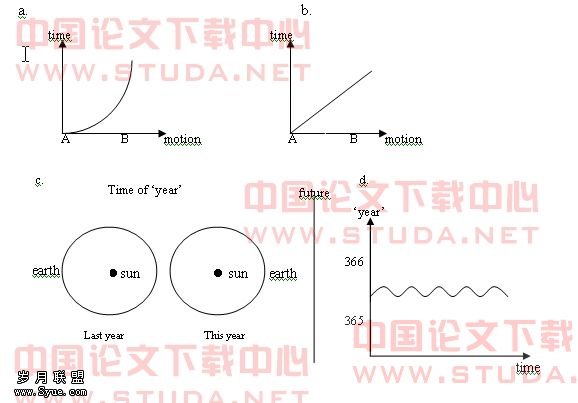
“图表 a” 和 “图表 b”是“某种运动与时间”关系的一种不同的坐标描述方法,也就是某种运动从位置A(Position A )到位置B(Position B)的时间变化图,即,时间随着某种运动的变化是如何变化的。“图表a” 表示某种非直线运动的时间变化图;“图表 b” 表示某种直线运动的时间变化图。从这两个图中,我们可以看出某种运动的时间运行(形状)可以是直线的,也可以是曲线的。
Figure a. and Figure b indicated that we could draw the coordinates of “motion and time” in a different way. The two charts depicted the changes of time with respect to a certain motion from position A to B--time changed following with the changes of a certain motion. “Figure a” showed us how the time changed when the motion moved along with non-straight line;“Figure b” described the time’s changes while the motion went a straight line. We were also told from pictures that the time’s running (shape) of certain motion could be curved or straight.
举一个具体例子,一辆汽车(M)从A点出发,最后到达B点。如果M走一条直线,则M从A到B经历的时间是直线的,如图b;如果M走的是一条曲线,则M从A到B经历的时间就是曲线的。多说一句,M从A到B经历的时间等于M从A到B每一点的时间累积。(详看3.6 节)
Now taking a real instance, a car (M) started from point A and arrived at point B. If M went along with a straight line, it was regarded the time of M’s travel from A to B was straight (figure b); If M traveled along with a curved line, it was regarded the time of M’s travel from A to B was curved or non-straight line (figure a). The interval of M’s traveling from A to B equaled to the cumulating times, which M spent by going through every point from A to B. Detailed in section 6 below.
看“图表c,”它描述的是“年”与时间(time)的关系。我们暂且把地球绕太阳公转看成是圆形的。这个周期(客观时间)就是这个圆上的时间“一点一点”组成的,我们可以说这个周期(客观时间)是圆形的。 现在我们把这个周期人为定义为“年,” ( year) 大家知道,“年”也是有变化的,“年”并不是绝对的365天,“年”的平均时间是365.2421天。通常“今年”(this year)与 “去年”(last year)是不相同,这就是我们公历(the Gregorian calendar or solar calendar)有闰年(leap year)的原因。再如,一般情况下,我们知道时钟和手表都有“秒针,”时钟和手表的秒针转一圈,它告诉我们时间过去了一分钟,而对于“秒针”来说它经历的时间也是个圆形的。
From Figure c, it depicts the relationship of “year” and “time.” Here, the orbit of the Earth’s moving around the Sun is tentatively considered round. This period (a kind of objective times) consists of every “point of time” on this circle, so we can call this period is round. Now we change to call this period as “year.” “Year” is not exactly equal to “365 days” or “366 days.” It equals to 365.2421 days on average. “This year” is normally different from “last year,” that is why our calendar(the Gregorian calendar or solar calendar)has leap year. For another example, the watch or clock has “second hand.” The second hand goes a circuit that tells us time passes a minute. For the “second hand”, time it went through could be called “round in shape.”
再来看看“图表d,”这个图是用另一种方式表示地球绕太阳公转周期与时间的关系,我们就用“年”(year)概念表示,“年”的变化范围从365天到366天之间。从这个图中,我们看到时间“年”被描述成一个曲线形。
我们还可以得出,如何去描述时间的性取决于你想告诉大家什么,比如,从“图表c,”你可以说“年”这个时间是圆形的;或者,从“图表d,”你可以说,“年”是在365天和366天之间变化的,并且“年”在这个时间坐标里表现出的是曲线形的。
From Figure d, it shows the relationship of “year” and “time” in different way. “Year” varies from 365 days to 366 days. From this chart, we see the time (“year”) was also described as a curved line. How to describe the regularities of times depends on what you want to tell, for example, “year” is round” (Figure c), or “year” varies from 365 days to 366 days (Figure d) and “year” is curved in the time coordinate.
通过上面的一些图例,我们可以得出这样的结论:时间可以是直线的,时间可以是曲线的,时间可以是圆形的,结论是,时间有形状,但没有固定形状。
According to the paradigms and diagrams above, we can draw a conclusion that time can be straight, time can be curved and time can be rounded. In result, time has shape, but has not fixed shape.
这里需要提醒注意的是,我们应当区分具体时间概念和抽象时间概念。具体时间是可以被度量的,它也是我们度量系统的一部分;抽象时间说的是时间的定义和时间的本质,就是说,抽象时间不可以用来度量的。
上面的章节中,我们已经对具体时间概念(包括客观时间和主观时间等等概念)有了许多讨论,下面我们将讨论时间的一般概念(抽象概念)问题。希望以前的讨论会对我们下面对时间的进一步研究有所帮助。
It needs to mention that we must distinguish the concrete concept of time from the abstract concept of time. The concrete time can be measured—it is a part of our measurement systems; the abstract time is known as the definition of time and the essence of time, and the abstract time can not be measured.
We have already discussed the concrete concept of time (included the objective time, the subjective time and many other notions), which could be helpful to understand the abstract concept of time below.
5.时间的定义是什么? 时间的本质是什么?
What is the definition of time? What is the essence of time?
什么是时间?回答这个问题也就是找出时间的定义和时间的本质。家和家从没有停止过对时间的探讨。科学上两次重大飞跃的代表人物牛顿和爱因斯坦,其理论都是和时间概念紧密相连的。可惜的是他们的注意力是在物上,而并没有认真思考时间的定义和解释时间的本质。
What is time? Answering what is time, namely we would find out the definition and the essence of time. How to define the time is a longstanding issue in science and in philosophy. Two science representatives—Isaac Newton and Albert Einstein, their theories intensively referred to time. Regrettably they did not seriously speculate what was the definition of time and what was the essence of time.
我们现在对时间的概念大部分被相对论的时空概念所左右,对时间的理解也仅停留在时间是“相对”的概念上。我认为,相对时间概念不能看成比绝对时间概念优越,不准确地说,它们是“钱币”的两个方面。另外,我们可以得到的时间定义主要来源于字典和百科全书,其定义也是各不相同,下面我列出一些它们对时间的解释,这些诠释基本代表了人类以前对时间的主流认识。
Nowadays our understandings of time, in any case, have been mastered by Relativity, and most people still remain realizing that time was merely relative. In my opinion, the “relative concept” of time was not considered prior to the “absolute concept” of time, and imprecisely they looked like a double-sides coin. In addition, we had to face the different explanations of time while looking up the dictionaries and encyclopedia. The viewpoints I listed below basically represented our previous comprehension of time.
Oxford Dictionary:
Time: the indefinite continued progress of existence, events, etc., in past, present, and future regarded as a whole.
Longman Dictionary:
Time: a continuous measurable quantity from the past, through the present, and into the future.
The American Heritage Dictionary:
Time: a non-spatial linear continuum in which events occur in an apparently irreversible succession.
Interpretation from Wikipedia—web-based encyclopedia (Aug. 22, 2006)
Time generally refers to the concept of a universal process or medium which allows all physical changes in the present to become events in the past. …
Time has been a major subject of science, philosophy and art. Though dictionaries present some (varied) definitions of time, it is difficult to provide an uncontroversial definition because there are wildly divergent views about its meaning, and concerns about where there are any simpler terms with which to define it. … To avoid these definitional problems, many fields use an ‘operational definition’ in which only the units of measurement are defined.
From Encyclopedia Britannica
Time is a measured or measurable period, a continuum that lacks spatial dimensions. Time is of philosophical interest and is also the subject of mathematical and scientific investigation.
我们还可以查到一些其他解释,我不能说它们都是错的,就像我说“时间就是时间”一样,或者绝大多数解释都是描述了一个时间的发生过程。你所看到的对时间的解释,包括上面列出的,也许可以帮助你接下来我对时间定义和时间本质的论述。
We could still find out some other definitions, which I could hardly say they were wrong, such as I said “time is time,” or most of them described a process of time occurrence. Some, including the viewpoints listed above, probably could help you understand the definition of time and the essence of time subsequently.
时间的定义:时间是任何变化的反映或描述。
The definition of time: Time is the reflection or description of change.
所谓变化就是一种状态从原态发成到不同。时间是变化的反映就是说,只要有变化就有时间的发生(产生),或者说,没有变化就不会有时间。因此,我们可以得出这个结论,变化是时间的主体,而不是其他。那人类是不是时间的主体呢,当然不是,因为没有人类,时间依然存在。
Change means that a state occurs from same to different. Time is the reflection of change means there are occurrences of time as long as there are changes, i.e. if there is no change, there is no time. Therefore, we could get a conclusion that Change is the only subject of time, no others. However, if humans are the subject of time, the answer is no, because there are no humans, time still can exist.
我们先不去管哲学上关于主体和客体的争论,这里说的主体与客体的关系意思是,没有主体(主的,主因)就没有客体(从属的)存在,也就是说,客体(时间)服从(屈从)与主体(变化)。
Regardless of the argument about the subject and object in philosophy, here in the article referring to the subject and object, it means if there is no subject (main or main cause), there is no reason for object (subordinate) to exist, in another word, the object (e.g. time) must yield to the subject (e.g. change).
需要提一句,时间不是唯一描述变化的。我们知道空间有变化,例如,汽球的空间可大可小;物质有变化,例如,物质的运动,物质的体积,物质的形态都可能有变化;我们的思想也有变化,例如,昨天你还认为地球是平的,今天就认为是圆的了;当然,时间本身也有变化,最简单的例子,我们都知道时间是不停往前走,“现在”的后面是“过去,”“现在”的前面是‘未来’。所有这些变化都可以用时间来描述,例如,在重力的作用下,空间从状态A弯曲到状态B,花了3秒钟;月亮绕地球的运行周期大约是29.53天(这就是阴历月的由来),等等。
需要注意的是,时间并不是反映或描述空间,物质等具体的个体的,而是反映和描述它们的变化的,时间,空间,物质都是独立的存在。
Time is also considered merely to describe the change. We know space could change, e.g., the space inside a balloon could be smaller or bigger, or space could be curved; matter could change, e.g., the motion and the volume of matter could change; our thoughts could change, e.g. yesterday he thought the Earth is flat, but today he thought the Earth is round; certainly time itself could change, to take an instance, we know time goes towards the future, the past is behind the present, the future is ahead of the present. All changes mentioned above can be described by using the concept of time, e.g., the change of space which curved by gravitation from state A to state B took three seconds; the period of the Moon’s rotation around the Earth is about 29.53 days(called “month” in lunar calendar) and so on. And time did not reflect or describe the space or matter other than their changes, i.e. time did not mean to describe certain bodies, but their changes. It needs to mention here that time, space and matter are different and independent existences
变化当然也可以用其他概念来描述,例如,长度,质量,温度,力,面积,速度,功率等,它们都可以反映某种存在或现象的变化。用什么概念去描述某种存在或现象,这要看你想去研究这种存在或现象的什么样的规律性或规则。去描述我们生活中的某个事件,我们可以选择用时间这个概念,当然,也可以选择其他的概念,例如,“这辆车的事故发生在3天前;”“这辆车发生了事故是因为天气恶劣。”
Also, change can be described by using other concepts, for example, length, mass, temperature, force, area, velocity, power, etc., they can also tell us the changes of certain existences or phenomena, and what existences or phenomena we want to describe by using the concepts above depends on what regularities or laws we want to tell. To describe the events in our lives, we can choose the concept of time, of course, as well as other concepts, e.g., “the car accident happened three days ago;” “the car accident happened because of the bad weather.”
宇宙中包括宇宙本身,永远存在变化,如果宇宙中没有了变化,宇宙就结束了,时间也无从谈起。说宇宙是物质的或运动的,不如说宇宙是变化的。我们顺便看一下物理上运动的定义:一个物体相应另一个物体的位置变化。(大英百科)
我们知道,要描述和定义一个概念(比如,宇宙),应该包括它所有的组成。宇宙的组成不仅有物质部分,它还有非物质(non-matter) 部分,例如空间,时间,意识都是非物质部分,因此,不能说宇宙就是物质的。
Always, there are changes in the universe and universe itself. If there were not changes, the universe would end, and we would have no way to talk about time. The universe would rather be called substantial or in motion than the universe is always in change. Now take a look at the definition of motion in physics that motion means the change of position of one body with respect to another ( Encyclopedia).
To depict or define a certain concept (e.g., the Universe), we have to tell the whole compositions of this concept. The universe consists of not only the physical parts but also the non-matter parts (e.g. non-matter parts include space, time, consciousness, etc.), as a consequence, we could not call the universe is only substantial or physical.
传统上,科学的是围绕“物质概念”展开的,因此上,从某种角度说,这个世界是也就建立在某种“物质”上了,因而,对宇宙中非物质部分的研究相对进展较慢,尽管对意识对争论持续了几千年,但到现在我们还是没有弄懂意识的本质是什么,可喜的是,我们已有了思维科学的研究,当然,伦理和道德规范也包括在里面了,困难的是,我们必须用思维去研究思维。
In tradition, science developed around the “the concept of matter,” and similarly, in some ways, our world was built up by “matter,” and the researches of non-matter parts developed slowly. Though the arguments of consciousness lasted for thousands of years, we have not known what the essence of consciousness should be. It is congratulated that some people established the brain science or thinking science, as well as “ethics”. The hard thing is to use thinking to think thinking.
相对论让我们对空间和时间有了进一步认识,令人困惑的是,爱因斯坦把时间和空间绑在了一起,而后来的继承者也无没有把时空(space-time)拆开,也就是说,他们忽略了时间的客观性,即时间是一种客观存在,并不是他们认为的是想像的“东西。”另外,根据相对论,时空是一起被弯曲的,我们已经知道变化是时间的主体,我很想知道引力如何能扭曲“变化。”还有,我也想知道,为什么没有定义空间的国际单位,也没有人合理地解答空间的本质,相比之下,我们却有时间的国际单位,而接下来我会对时间的本质进行解释,这里,我不想谈论太多关于空间的事,我想强调的是,时间是用来描述空间的变化的,而不是用来描述空间本身,时间是不从属空间的。
And Relativity has made us understand space and time more, but it was confusing that Albert Einstein bound up space and time into together. Moreover, the successors were not able to take “space-time” apart, i.e. actually they neglected time’s objectivity--time is a kind of existences and it is not an imaginary thing. In addition, according to Relativity, space-time could be curved together. We have already known that change is the subject of time,and I really want to know how the gravitation would curve the “change.” And also I was wondering why we could not define the unit of space or could not answer the essence of space, by contrast, time had its unit(s), and I will answer the essence of time later on. I would not like to talk space much here, what I concerned is that time is to describe the change of space, and not space itself. Time does not subject to space.
时间的本质是什么?
What is the essence of time?
几乎每个人家里都有时钟(clock)。时钟的“滴答声”让我们意识到时间的存在,它还告诉我们时间正在流逝。时间总是流向未来,就算宇宙膨胀到一定时候往回坍缩,宇宙时间还是向前走的,膨胀(Big Rip)和坍缩(Big Crunch)应看成是宇宙变化全过程中的一部分。时间是否可以回到过去?我觉得想像是一种财富,我的确很想重过大学生活。
Almost every family has the clock on the wall. The ticks from the clock tell us the existence of time, and also let us know time is elapsing. Time always flows towards the future, even if the universe should collapse back when the expansion stopped, the universal time would still proceed. The collapse (Big Crunch) and expansion (Big Rip) should be regarded as the parts of the whole evolution of the Cosmos. Could time go back to the past? I really think the imagination is a kind of treasures, and I really wish to go back to the university to study again.
时间是一种存在,它既是客观的,又是主观的。客观性就是不受思想所支配,或独立于意识之外的存在,例如,月亮绕地球的运行周期,它在人类出现之前就存在着。时间又是主观的,例如,我们日历的月份(month)可以定义为30天,也可以定义为31天,而2月份(Feb.),我们有28天和29天。最好不要去修改客观时间,比如,把月亮“推”得运行快一些,但主观时间可以根据具体情况进行调整,夏时制(Daylight Saving Time)就是一个例子。
Time is a kind of existences, and it is objective as well as subjective. Talking about its objectivity—a thing external to the thinking mind (consciousness) or subject, for example, as known, the period of the Moon’s rotation around the Earth, it existed much earlier than humans did. Time could be subjective, for example, the “month”, a kind of subjective times, in our actual calendar is defined as some are 31 days, some are 30 days and February can be altered as 28 days or 29 days. It would be the better way not to change the objective time, e.g. “pushing” the Moon to move more quickly. But the subjective time can be adjusted by us, which Daylight Saving Time (DST) is a good example.
时间的本质,我归纳以下几点:
时间是一种存在,既是客观的,又是主观的。
变化是时间的主体,而不是其他;没有变化就不产生时间。
时间由时间单位组成。
时间没有固定形状,时间流向未来。
The essence of time is concluded below by far we know:
Time is a kind of existences; it is both objective and subjective.
Change is the only subject of time, no others; if there is no change, there is no occurrence of time.
Time consists of the unit (units) of time.
Time has not fixed shape; time goes (flows) towards the future.
6. 时间的表达式(the formulation of time)
The formulation of time
时间是客观世界的一种存在;时间也可以有规律性。我们以往习惯于通过时间坐标研究某种事情的变化(例如,运动);实事上,我们很少通过坐标来研究时间的变化。方便起见,我建议今后使用坐标系来研究时间时,用x-time 暗示“x”为纵坐标轴,“time”为横坐标轴;time-x 暗示为“time”为纵坐标轴(ordinate),“x”为横坐标轴(abscissa)。
为和测量某一具体时间(t),我这里给出一个时间的表达式:
总体阐述:
• 时间(t)等于每一事情(every thing)从原状态A发生到不同状态B的每一个时间单位的积分。
• 时间不会自行倒退。
时间的数学表达式:
• t = f(x)
• t = ∫abf(x)dx
x在区间[a,b]里。
Time is a kind of existences in the universe, therefore time could have regularity. Before now, we usually studied the changes of the certain “things” by time coordinates, and in fact we seldom studied the changes of time by the coordinate systems. For the convenience, I would like to suggest, when we depict the coordinates referring to time in the future, that “x-time” would imply “x” as ordinate and “time” as abscissa; “time-x” would imply “time” as ordinate and “x” as abscissa.
To compute or measure a certain time (t), below indicate the formulation of time.
General formulation:
• Time (t), that occurred when every thing happened from same state (A) to different state (B), equals to the integrals of every unit of time.
• Time can not go backwards automatically.
The expression in mathematics:
• t = f(x)
• t = ∫abf(x)dx
x on the interval [a,b]
7. 时间系统图
The chart of “Time System”
具体的时间包括客观时间和主观时间,我们可以发现和利用客观时间,而主观时间则是我们人类的应用时间。下面这个图表或许可以帮助你理解和记忆整个时间概念。
The concrete times refer to the objective time and the subjective time. The objective time might be discovered and utilized by us, and the subjective time is our applied time system. This chart might help us remember and comprehend the concept of time.
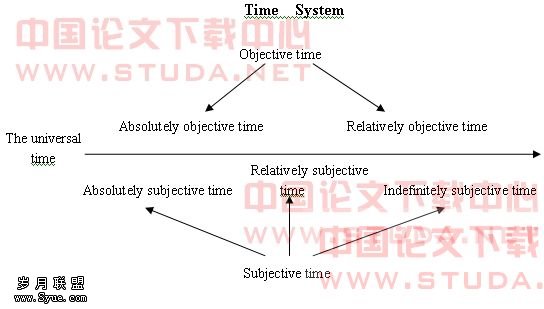
结束语:
End remarks:
时间理论不仅是呈现了对时间进行了分类和对时间的全面阐述,而更重要的是它反映出的是我们在探索宇宙真理过程中的一次努力。所谓的“宇宙真理,”我的理解是应当包括以下内容:
创造或发生。即宇宙与人类起源问题。
简单说一句,世界上许许多多的人相信创造论,先不去管谁对谁错,大家都是在探讨真理和生命的意义。
存在与现象的解释。即宇宙与宇宙中的规律性问题。
宇宙的定义与本质。即哲学上的宇宙概念问题。
宇宙与人类命运问题。
寻求宇宙真理使得我们的生命和人类的生活变得有了意义。
The theory of time has shown not only the classification and interpretation of time, but also importantly it reflected one of our efforts of the explorations for the Truth of the Cosmos. So-called the Truth of the Cosmos, I realized it should include some contents below:
Created or occurred naturally, namely the questions about the origin of the Cosmos and man.
Interpretations of existences and phenomena, namely the questions about the laws or rules of the Cosmos itself, existences and phenomena in the Cosmos.
Definition and essence of the Cosmos, namely the philosophical notion of the Cosmos.
Destiny of the Cosmos and human beings.
Seeking for the Truth of the Cosmos makes the life of humankind become significant.
